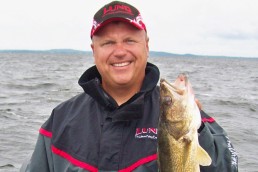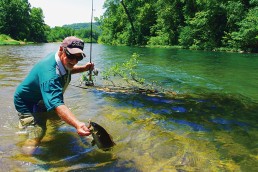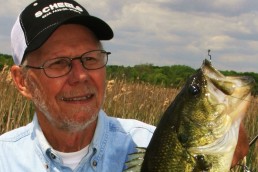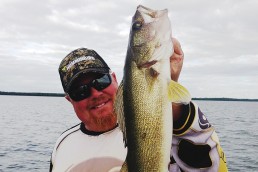Long Lines for the Opener
SHARE THIS POST
Opening day for walleyes in Minnesota is considered a holiday. One could argue that it is a holiday since it often shares the weekend with Mother’s Day. The opener often brings many challenges with it including cold temperatures and strong winds or rain or snow. These conditions can test even the most seasoned angler. But the start of the season brings out the most walleye fishermen as they cover lakes and their favorite hot spots with many boats.
Long-lining and trolling minnow baits can help you stay comfortable, avoid the crowds and cover more water. This can translate into more of Minnesota’s state fish in a boat and more smiles. How you make sure to keep smiles on the faces of the important women in your life on Mother’s Day is up to you. Both events are important to me, so I always have a plan to balance the weekend.
On a recent walleye opener on Mille Lacs Lake, my partners and I were faced with cold water, cold air temperatures and gusty winds. As is always the case on Mille Lacs for the opener, we were also faced with lots of boats. Drawing on countless past experiences, we reasoned that the fish would be shallow—very shallow. We agreed that fishing deeper than 6 feet would be a waste of time. This kept us from having to venture out very far into rolling waves, as we remained in a somewhat sheltered bay and kept away from many overcrowded hot spots farther out in the lake.
We chose a technique that we use often on the opener and the rest of the spring: long-lining shallow-running minnow baits while tolling across shoreline flats near suspected spawning areas. Walleyes, especially the males, will linger near the spawning areas for a while after the spawning ritual is finished, and as long as there’s prey in the area. Sand or gravel flats adjacent to rocky or gravel shorelines are good spots. If these areas have some new weeds or a current area such as a channel between lakes or a feeder stream, prey will most likely be found, and so will walleyes.
For that cold, windy day, we chose a gravel flat near a rocky shoreline with a feeder stream entering in. The flat was 4 to 7 feet deep before dropping into deeper water. Walleyes will usually be scattered in areas like this so it helps to choose a strategy that can cover some water. We knew it would be necessary to keep the speed of the presentation to a minimum in this cold water in the cold-front conditions. We needed to choose baits that put out good action at a slow speed and could dive somewhere in the area of 4 to 6 feet at that slower speed. We also knew we would have to run baits a good distance behind the boat in the shallower water. Here, walleyes will move out to the side of a boat’s path to avoid being passed over, and then will often move back to their original path after the boat has passed. Running your baits 100 feet or more behind the boat will allow for walleyes to return to the path of these baits after the boat passes. Also, run baits behind small inline planer boards. If you are trolling a large flat, planer boards can help you cover more water by spreading out baits. They also help for running multiple lines on lakes where more than one line per person is allowed.
Are you enjoying this post?
You can be among the first to get the latest info on where to go, what to use and how to use it!
For early-season walleyes, trolling thin minnow baits in these above areas is ideal. These baits have a subtler wobble than fatter crankbaits and trigger walleyes better in cold water and run at the shallow depths required for this pattern. The Rapala Original Floating Minnow is a great springtime trolling bait, as it has that enticing Rapala wobble and runs somewhere from 4 to 6 feet deep depending on speed and amount of line that’s out.
For Mille Lacs, that day we ran number 13 Floating Rapalas. The three of us put out the Black and Silver number 13, a Black and Gold number 13 and a Perch number 13. Always run multiple colors until the fish show a color preference. We experimented that day with number 11 Floating Rapalas too, which are slightly smaller and run just slightly shallower. But the fish wanted a 13 Black and Silver. For slow-trolling minnow baits in shallow water, I like to use a 7-foot, medium-power, moderate-action baitcasting combo spooled with 10-pound-test Berkley FireLine Crystal. I tie the line to a small crankbait snap to attach it to the bait. The crankbait snap allows subtle-action baits to swim better and allows you to try different baits without cutting and retying. Finally, a baitcasting rod-and-reel combo allows you to put the rod in a rod-holder, if you want or need to. For that bitterly cold opener, we had the rods in holders so we could keep our hands warm in our coat pockets. If you choose to hold onto your rod while trolling, try “sweeping” the rod forward a few feet and then try “falling back” to the rod’s original position every so often. The sudden change in speed of the bait, and the move it creates, triggers an uncommitted, following fish to strike. Make sure you hold on tight to the rod as you do this. Throttling up the engine for a second or two every once in a while will also create the same effect with rods in the holders.
This pattern works after the weather and water has warmed. In Minnesota, this pattern is effective throughout May and the first half of June. Until the deeper weeds in a lake thicken up and turn green, much of the lake’s forage will be on the shoreline flats as will many of the lake’s predators. Several manufacturers make deep-running minnow baits, such as the Rapala Minnow Rap, that will work well on deeper lakes where the shoreline flats are deeper, say 8 to 15. This pattern will produce mainly walleyes and northerns, but you will catch an occasional bass or crappie as you troll these shoreline flats in spring.
So, how did the three of us do on that raw opening day?
It took about an hour to pattern the fish, as they wanted a number 13 Black/Silver Floating Rapala trolled at 1.4 to 1.6 mph, and 140 to 160 feet behind our boat. In four hours we caught 14 walleyes, from 18 to 25 inches, and three northerns all around 28 inches. We weren’t surprised—we had caught hundreds of walleyes using this technique in May and June over the years, and had always enjoyed a day of trolling. This technique is also a great way to chase walleyes with kids or inexperienced anglers. It’s a simple presentation: put the rods in the rod holders and watch for one to bend over.
MWO
SHARE THIS POST
Did you enjoy this post?
You can be among the first to get the latest info on where to go, what to use and how to use it!
Troy Smutka
Troy Smutka is a central Minnesota fishing guide (greatdayonthewater.com) and a walleye tournament angler. He is also a member of the Lund Boats, Mercury Outboards and Johnson Outdoors Pro Teams, and hosts and produces Fishing and Hunting the North Country on YouTube.



